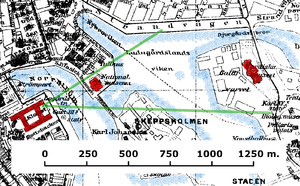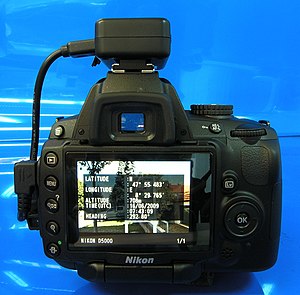Geotagged photograph: Difference between revisions
m r2.5.1) (robot Modifying: de:Geotagging (Fotografie) |
→Automatic using a built in GPS: Adding Panasonic Lumix DMC-TZ10, which is a current model with GPS |
||
| Line 11: | Line 11: | ||
Several manufacturers offer cameras with a built-in GPS receiver, but most cameras with this capability are [[camera phone]]s as camera manufacturers after initial experience in the market came to treat GPS cameras as a [[niche market]]. <ref> [http://gadgetwise.blogs.nytimes.com/2010/07/28/why-dont-more-cameras-offer-gps/ New York Times Gadgetwise 2010/07/28] Why don't more cameras offer GPS?</ref> The 2008 Nikon P6000, for example, an early geotagging camera, was replaced in 2010 by the P7000 which lacked that feature.<ref>[http://crave.cnet.co.uk/digitalcameras/nikon-coolpix-p7000-nikon-says-no-to-gps-50000673/ CNET UK] Nikon says No to GPS</ref> Some models also include a compass to indicate the direction the camera was facing when the picture was taken. |
Several manufacturers offer cameras with a built-in GPS receiver, but most cameras with this capability are [[camera phone]]s as camera manufacturers after initial experience in the market came to treat GPS cameras as a [[niche market]]. <ref> [http://gadgetwise.blogs.nytimes.com/2010/07/28/why-dont-more-cameras-offer-gps/ New York Times Gadgetwise 2010/07/28] Why don't more cameras offer GPS?</ref> The 2008 Nikon P6000, for example, an early geotagging camera, was replaced in 2010 by the P7000 which lacked that feature.<ref>[http://crave.cnet.co.uk/digitalcameras/nikon-coolpix-p7000-nikon-says-no-to-gps-50000673/ CNET UK] Nikon says No to GPS</ref> Some models also include a compass to indicate the direction the camera was facing when the picture was taken. |
||
* [[Panasonic Lumix DMC-TZ10]] |
|||
* [[Sony Alpha 55]]V ([[DSLR]]) |
* [[Sony Alpha 55]]V ([[DSLR]]) |
||
* Sony DSC-HX5V |
* Sony DSC-HX5V |
||
Revision as of 19:56, 6 March 2011
It has been suggested that this article be merged with Geotagging. (Discuss) Proposed since May 2010. |


A geotagged photograph is a photograph which is associated with a geographical location by geotagging. Usually this is done by assigning at least a latitude and longitude to the image, and optionally altitude, compass bearing and other fields may also be included.
In theory, every part of a picture can be tied to a geographic location, but in the most typical application, only the position of the photographer is associated with the entire digital image. This has implications for search and retrieval. For example, photos of a mountain summit can be taken from different positions miles apart. To find all images of a particular summit in an image database, all photos taken within a reasonable distance must be considered. The point position of the photographer can in some cases include the bearing, the direction the camera was pointing.
Methods of geotagging photographs
There are a few methods of geotagging photographs, either automatic or manual. Automatic methods provide the easiest and most precise method of geotagging an image, providing that a good signal has been acquired at the time of taking the photo.
Automatic using a built in GPS
Several manufacturers offer cameras with a built-in GPS receiver, but most cameras with this capability are camera phones as camera manufacturers after initial experience in the market came to treat GPS cameras as a niche market. [1] The 2008 Nikon P6000, for example, an early geotagging camera, was replaced in 2010 by the P7000 which lacked that feature.[2] Some models also include a compass to indicate the direction the camera was facing when the picture was taken.
- Panasonic Lumix DMC-TZ10
- Sony Alpha 55V (DSLR)
- Sony DSC-HX5V
- Compact Camera Casio EX-10HG is advertised as Hybrid-GPS.[3]
- Some mobile phones with assisted GPS use the cell phone network to speed GPS acquisition times.
Automatic using a connected GPS

Some digital cameras and camera phones support an external GPS receiver connected by cable or inserted into the memory card slot or flash shoe. Generally the relevant GPS data is automatically stored in the photo's EXIF information when the photo is taken. A connected GPS will generally remain switched on continuously, requiring power, and will then have location information available immediately when the camera is switched on.
Many GPS-ready cameras are currently available, made by manufacturers such as Nikon, Fujifilm, Sony and Panasonic.
Nikon uses the remote control socket as the GPS interface. Since 2009 Nikon sells its own Geotagger GP-1. Canon uses the USB socket on the wireless file transmitter unit (WFT) as the GPS interface.
Automatic geotagging combined with real-time transfer and publishing results in real-time geotagging.
Synchronizing with a separate GPS
Most cameras sold today do not contain a built-in GPS receiver; however, an external location-aware device, such as a hand-held GPS logger, can still be used with a non-GPS digital camera for geotagging. The photo is taken without geographical information and is processed later using software in conjunction with the GPS data. Timestamps made by the camera can be compared with timestamps in the recorded GPS information, provided that the clocks in the separate devices can be synchronized. The resulting coordinates can then be added to the EXIF information of the photo.
However, this method is somewhat troublesome with post processing. Users have reported problems when synchronizing the photos with the GPS track due to difference in timestamps.[citation needed]
Manual geotagging
Location information can also be added to photos, for example via its Exif specification that has fields for longitude/latitude, even if no GPS device was present when the photo was taken.
The information can be entered by directly giving the coordinates or by selecting a location from a map using software tools. Some tools allow entry of tags such as city, postal code or a street address. Geocoding and reverse geocoding can be used to convert between locations and addresses.
Remote standoff capture
Some manufacturers of professional mapping-grade GPS instruments have integrated a GPS receiver with a laser rangefinder and digital camera. These multi-functional tools enable the capture of a remote geographical position (up to 3280 feet/1000meters) and link the photograph to the subject's location, independent of the photographer’s position. These instruments are commonly used when the user is unable to reach and be on the target, the position is inaccessible (for example over a valley or wetland), there are personal health & safety concerns (motorway traffic), or the user wants to quickly capture multiple targets from a single, safe position (trees, street signage and furniture).
Integrated GPS cameras with rangefinders and remote standoff capability are currently available made by manufacturers such as Ricoh and Surveylab.
Uses
When geotagged photos are uploaded to online sharing communities such as Flickr, Panoramio or Moblog, the photo can be placed onto a map to view the location the photo was taken. In this way, users can browse photos from a map, search for photos from a given area, and find related photos of the same place from other users.
Many smartphones automatically geotag their photos by default. Photographers who prefer not to reveal their location can turn this feature off. [4]
See also
References
- ^ New York Times Gadgetwise 2010/07/28 Why don't more cameras offer GPS?
- ^ CNET UK Nikon says No to GPS
- ^ http://www.engadget.com/2010/02/22/casios-gps-equipped-ex-10hg-camera-gets-a-price-launch-date/
- ^ US Army
This article needs additional citations for verification. (January 2008) |
